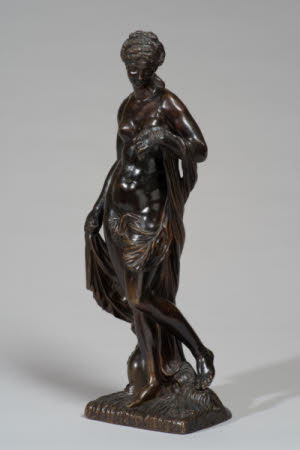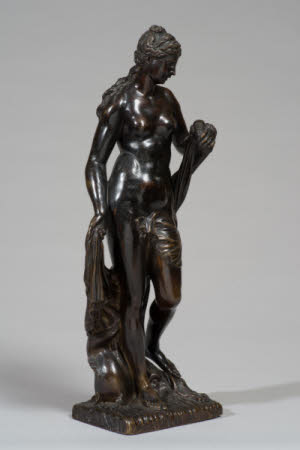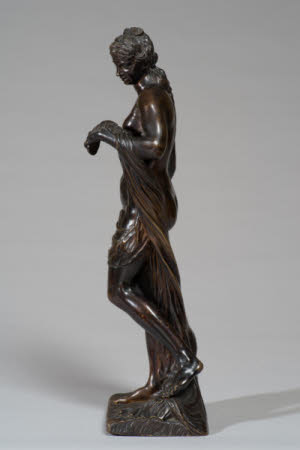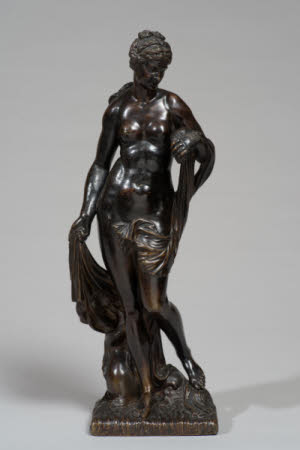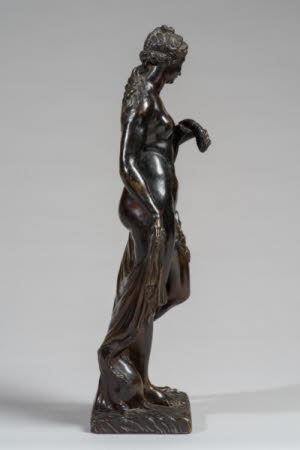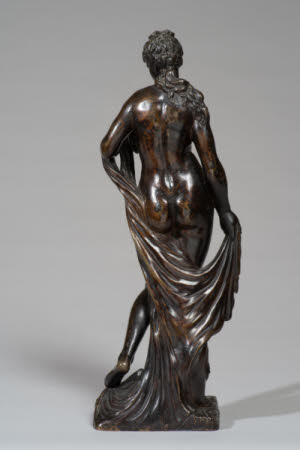Amphitrite
after Michel Anguier (Eu c.1612 - Paris 1686)
Category
Art / Sculpture
Date
c. 1652 (model) - 1690 - 1700 (cast)
Materials
Bronze
Measurements
372 x 120 x 95 mm
Place of origin
Paris
Order this imageCollection
Anglesey Abbey, Cambridgeshire
NT 515055
Summary
Bronze, Amphitrite, after a model by Michel Anguier (1612/14- 1686), Paris, France, model c. 1652, cast probably c. 1690-1700. A bronze figure of Amphitrite, wife of the sea god Neptune, after a model by Michel Anguier. The figure is paired with a statuette of Bacchus (NT 515056), after Louis Garnier (c. 1639-1728). These very fine bronze figures were probably cast in the late 17th century. Amphitrite stands, naked except for a swag of drapery sweeping round behind her and seeming to frame her figure. She appears absorbed in contemplation of a crustacean, probably a crayfish, that she gently holds in her left hand. To her right, a dolphin’s head is partly covered by the drapery, the animal looking out from between Amphitrite’s legs. The terrasse base is modelled in the form of running rivulets of water. There is a hole in its centre, which would have allowed the bronze to be fixed to a base, which was probably originally of ebonised wood or Boulle marquetry. The surfaces of the bronze figure are beautifully finished, with the dolphin’s tail and face carefully hammered, the hair carefully modelled and worked with a matting tool. Reddish varnish to bronze surface, over this a blackish lacquer.
Full description
This elegant bronze depicts Amphitrite, a sea nymph who was the spouse of Neptune, god of the sea. Naked except for the swag of drapery that sweeps round behind her and appears to frame her figure, Amphitrite appears absorbed in her contemplation of the crustacean that she gently holds in her left hand. The viewer’s attention is thus cleverly engaged, not by the principal figure of the nymph, but by the dolphin who peeks beadily out at us from beneath the swirls of drapery, where he and the cascading water on the base remind us of Amphitrite’s realm of the sea. The Amphitrite is an exceptionally graceful composition and extremely pleasing to the eye. Although the rectangular base and the slight flattening of the composition when seen from the side indicate that it is principally intended to be viewed frontally rather than in the round, some of the most beautiful elements in the composition, the buttocks subtly revealed by the falling drapery and the wonderful cascade of falling hair, can only be fully appreciated from the back. The statuette is a smaller version of one of a series of seven bronze figures of gods and goddesses made by the sculptor Michel Anguier (for discussion of the Amphitrite and other bronzes in the series, see Bresc-Bautier, Scherf and Draper 2009, pp. 204-225, nos. 55-62, the Amphitrite no. 55 and Warren 2010, pp. 138-57, nos. 12-13, the Amphitrite no. 12). Michel Anguier and his brother, François, came from Normandy. After training in Paris, they went to Rome, where Michel worked for both Alessandro Algardi and Gianlorenzo Bernini. In 1651 Anguier returned to France, where he was employed on major projects including the decoration of Anne of Austria’s apartments in the Louvre and the decoration of the Church of Val-de-Grâce in Paris. Whilst in Rome, Michel Anguier dedicated himself with great passion to the study of ancient statues and reliefs as well as the work of Algardi, Bernini and other contemporary Baroque masters. The lessons he brought back from Italy may be seen in his famous series of bronze figures of gods and goddesses, which were conceived as early as 1652, immediately following his return to France. Anguier seems to have planned three series of pairs of divine spouses: Jupiter and Juno; Neptune and Amphitrite; Pluto and Ceres. There is also a seventh figure of Mars, which Anguier seems to have paired with a Hercules. As Anguier’s contemporary Guillet de Saint-Georges observed in a paper read to the French Academy in 1690, the sculptor consciously sought in his three pairs of figures to represent contrasting emotions. In the case of the Neptune and Amphitrite, perhaps the most compositionally interesting of all the pairs, an ‘agitated’ and dynamic figure of Neptune is contrasted with the elegant figure of the ‘tranquil’ Amphitrite, engaged in contemplation of the crayfish held in her hand. The meaning of these figures is likely to have gone beyond their emotions, however. Anguier likewise gave theoretical lectures to the Academy. In 1676 he spoke on the representation of various gods according to their temperaments, reiterating the ancient theory of the elements and humours, as developed by the ancient Greek physicians Hippocrates and Galen. In this system, Anguier explained that the temperament of each individual was determined by differing combinations of the four humours or elements, hot, cold, dry and humid. He described Amphitrite as follows: ‘Just as the element of the air belongs to Juno, wife of Jupiter, in the same way is the water of the sea attributed to Amphitrite, wife of Neptune. She must have beautiful and elegant proportions. Her skin must be fresh, delicate, clear, transparent, her face and all her body agreeable. The soft, clear quality of her flesh must derive in the first instance from her delicate bone structure and from the correct thickness of flesh, which will be cold, moist, thick and weak. This type of flesh is agreeable and pleasant in all types of individuals so long as it does not exceed proper proportions, but it is indeed necessary to be cautious about the type of figure for which one uses it. Her draperies will be ample, delicate and undulating, just as the water around her is beautiful, delicate and in movement; you may call her blue, green, fish-like and immense, and these hues may serve for the draperies.’ (Lichtenstein and Michel 2006, pp. 597-600). The Neptune, an example of which is in the Victoria & Albert Museum (inv. A.206-1946, Warren 2010, p.141, fig. 1), shows direct knowledge of Bernini’s Neptune and Triton, made for the Villa Montalto in Rome in 1622, and today in the Victoria & Albert Museum, London. It is more difficult to identify a specific source for the Amphitrite. The figure presents obvious analogies with Classical Venus figures, but in fact Amphitrite’s pose relates most closely to another famous antique statue, the draped figure of the Farnese Flora which, during the 17th century, was in the courtyard of the Palazzo Farnese in Rome (Haskell and Penny 1981, pp. 217-19, no. 41, fig. 113). At the same time, the Amphitrite shows Anguier demonstrating significant awareness of Renaissance prototypes, in particular Primaticcio and the mannerist tradition in France. The crustacean held in Amphitrite’s hand recalls 16th-century prototypes, for example those nestling among the decoration of dishes painted by the late 16th-century Limoges enamel painter Martial Courteys. Although it has been described by almost all scholars as a lobster and is in fact biologically somewhat incoherent , it is probably intended as a specimen of the European or noble freshwater crayfish (astacus astacus), an animal that would have been a familiar sight in rivers and streams throughout France, as well as on dining tables. Of Anguier’s seven gods and goddesses, the Amphitrite, with its elegance and quiet, understated eroticism, was by far the most successful of all Anguier’s gods and goddesses in terms of its popularity, appealing to collectors from the time it was made. Full-size copies were made in stone, whilst the bronze figures are known in three sizes, a larger prime version (c. 53 cm.), and medium-sized (c. 37 cm.) and small (c. 27 cm.) versions. The example at Anglesey Abbey is medium-sized. This version is very often found, as it is at Anglesey Abbey, paired with a bronze of Bacchus, the model of which is attributed to Louis Garnier (c. 1639-1728). It is difficult to know when Anguier’s bronzes began to be cast, the larger-sized versions possibly from as early as the 1650s. The Bacchus seems to have been specifically designed to complement the Amphitrite, in a commercial venture that was perhaps initiated after Michel Anguier’s death in 1686, and in which Garnier had an active part in the designing of a new figure The earliest evidence for the Amphitrite/Bacchus medium-sized versions comes in 1699, when a pair was acquired in Paris for the collections of the Electors of Saxony in Dresden (today in the Grünes Gewölbe, Dresden; see Krahn 1995, pp. 568-71, nos. 218-19 and Warren 2010, p. 145, fig. 3). The Anglesey Abbey Amphitrite and Bacchus, superior in their quality to the pair in Dresden, are among the finest examples of the models at this size to survive. The surfaces are exceptionally carefully worked with tools such as small chisels and hammers, to produce a variegated effect that would have appeared even more magical, when the bronzes were illuminated by the flickering lights of candles. They also have a reddish varnish applied their surfaces, over this a blackish lacquer, a practice seen in French bronzes from the 16th and 17th centuries. A pair close in quality was sold by Sotheby’s in 2015 (Important Mobilier, Sculptures et Orfèvrerie Européenne, Sotheby’s Paris, 4-5 November 2015, lot 301). More broadly, the National Trust owns within its collections no fewer than five other examples of the Amphitrite: at Hatchlands Park (NT 1166752, bronze; large version); Hinton Ampner (NT 1530165; life-size stone version in garden); Polesden Lacey (NT 1246218; smallest version, paired with an unrelated Shepherd); Saltram (NT 871606.2; large version,also paired with the Shepherd); Tatton Park (NT 1297758; bronze, large version, paired with Mars). There is also an example of Anguier’s Pluto at Erddig (NT 1149420). Jeremy Warren 2020
Provenance
Acquired by Huttleston Rogers Broughton, 1st Lord Fairhaven (1896-1966) between 1932 and 1940; identifiable in the Anglesey Abbey inventory 1940, p. 75, Main Landing and stairs to upper floors, valued with NT 515056 at £21; bequeathed to the National Trust by Lord Fairhaven in 1966 with the house and the rest of the contents.
Credit line
Anglesey Abbey, The Fairhaven Collection (The National Trust)
Makers and roles
after Michel Anguier (Eu c.1612 - Paris 1686), sculptor
References
Bresc-Bautier, Scherf and Draper 2009: Geneviève Bresc-Bautier, Guilhem Scherf and James David Draper (eds.), Cast in Bronze: French Sculpture from Renaissance to Revolution, exh. cat., Metropolitan Museum of Art, New York, Paris 2009, pp. 204-225, nos. 55-62. Warren 2010: Jeremy Warren, Beauty and Power. Renaissance and Baroque Bronzes from the Peter Marino Collection, exh. cat., Wallace Collection, London 2010, pp. 138-57, nos. 12-13. Lichtenstein and Michel 2006: Jacqueline Lichtenstein and Christian Michel (eds.), Conférences de l’Académie royale de Peinture et de Sculpture. Les Conférences au temps d’Henry Testelin 1648-1681, 2 vols., Paris 2006, pp. 597-600. Haskell and Penny 1981: Francis Haskell and Nicholas Penny, Taste and the Antique, The Lure of Classical Sculpture 1500 - 1900, New Haven and London, 1981, pp. 217-19, no. 41, fig. 113. Krahn 1995: Volker Krahn (ed.), Von allen Seiten Schön. Bronzen der Renaissance und des Barock, exh. cat., Altes Museum, Berlin, Heidelberg 1995, pp. 568-71, nos. 218-19. 'Anglesey Abbey, Lode, Cambridgeshire. An Inventory and Valuation of Furniture, Books, Ornamental Items & Household Effects .. prepared for Insurance Purposes’, Turner, Lord and Ransom, April 1940, p. 75. Christie, Manson & Woods 1971: The National Trust, Anglesey Abbey, Cambridge. Inventory: Furniture, Textiles, Porcelain, Bronzes, Sculpture and Garden Ornaments’, 1971, p. 152.
